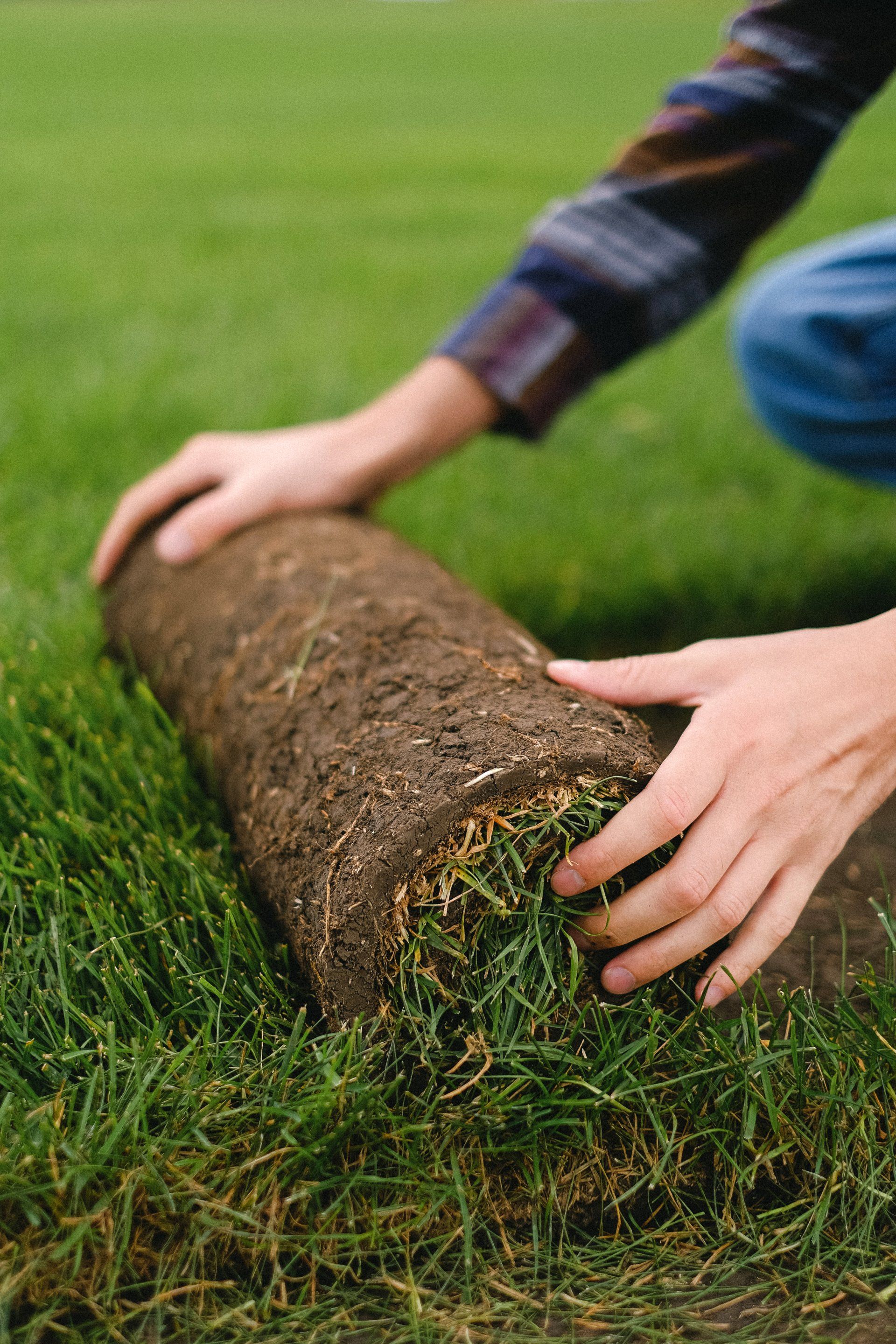Turfing Nottingham - Residential and Commercial Turf Laying
Telephone:
0115-647-1794
Turfing Services Nottingham
At our company, we understand the importance of having a healthy, green lawn and we strive to ensure that you get the results you want. Our team of experts will help you create the perfect landscape for your home or business with carefully planned designs and careful attention to detail. With years of experience in all aspects of turf installation and maintenance, we’ll make sure your lawn looks great while being low-maintenance and cost-effective.
Our professional turfing services are second to none. Our team of experienced technicians will ensure your lawn is looking its best with its comprehensive turf care program. We provide a range of services including turf installation, fertilisation, weed, and pest control, mowing, aeration, and over seeding. We also offer soil testing and nutrient balancing to make sure that your grass receives the right nutrition for optimal growth.
We use top-of-the-line equipment for precision cutting and edging, making sure that every blade of grass on your property looks perfect. Our professionals follow all safety guidelines during every job ensuring a safe workspace for everyone involved.
Our team of lawn-turfing professionals will work with you every step of the way to ensure that your turf is healthy, vibrant, and low-maintenance. We use state-of-the-art techniques such as topdressing, de-thatching, and core aeration to promote better root development and water absorption. Through our services, we’ll make sure that your lawn is looking its best all year round.
With our commitment to customer satisfaction, you can count on us to deliver excellent results at an affordable price. We take pride in providing exceptional service and quality products that are sure to keep your lawn looking its best. Contact us today for a free quote on our turfing services.
Lawn Turf Installation
Turfing a lawn is one of the most efficient ways to create a beautiful, lush landscape. Turf provides superior protection against pests and weeds, helps retain moisture for healthier plants and grasses, and ultimately creates an attractive look for your yard. Whether you are starting from scratch or remodelling an existing lawn, there are several steps involved when installing turf.
The first step in turfing a lawn is assessing the soil quality. You will need to conduct a soil test to determine the pH level of your soil and its nutrient levels, as this will have an effect on how well your turf grows in the future. Once you know what type of soil you're dealing with, you can go ahead with adding amendments such as compost or fertiliser to help improve the soil quality.
The second step is to prepare the surface for turf installation. This involves removing any existing debris and vegetation, such as weeds or rocks, from the site before laying down the turf. You should also till or spade up the soil in order to loosen it and create a more level surface - this will make it easier for you to install your turf evenly.
Thirdly, you will need to lay out your turf rolls on the prepared surface. Make sure that all of them fit together properly, with no gaps between them. It's important that you use a quality turf roll as this will ensure that your grass won't become patchy over time. Once everything is laid out correctly, you can cut along the edges to ensure a perfect fit.
Fourthly, you will need to fill in any gaps between the turf rolls with soil or sand - this is best done using a rake. Make sure that the soil or sand you use is even and level throughout so that your grass doesn't become patchy over time.
Finally, you'll need to water your newly turfed lawn for about an hour or two each day for the first week or two after installation. This will help promote deep-root growth and make sure that your turf has all of the nutrients it needs to thrive. After this initial period of watering, you can reduce it gradually until you reach your desired frequency - however, be careful not to allow your turf to become too dry, as this can lead to a host of problems such as weed infestation and disease. Additionally, make sure that your turf is receiving the right amount of sunlight, as some varieties need more than others in order to thrive. Finally, check for any pests or weeds that may be present and treat them accordingly - doing so will help ensure that your lawn stays looking healthy and vibrant for years to come. With these tips in mind, you'll be well on your way to a beautiful, lush green lawn!
How much does turfing cost UK?
The cost of turfing in the UK depends on a number of factors, including the type of turf, the size of the area to be turfed, and access to the site. Generally speaking, it is estimated that laying turf costs between £5 and £15 per square metre – but this can vary significantly depending on your location and the current market rate for turf. Ground preparation costs such as removal of existing vegetation or adding topsoil are also additional factors that can increase the overall cost.
It's important to get multiple quotes from reputable suppliers before making a decision – there could be significant price variations between providers so always shop around and make sure you understand exactly what is included in each quote. Additionally, you should always ensure that any contractor you choose is certified and insured. This will provide you with peace of mind that your turf installation is being carried out correctly and safely.
Turfing costs in the UK can also be impacted by any additional services which may be required, such as levelling or aeration of the soil, laying a membrane to inhibit weed growth, or edging along borders and paths. All of these jobs should also be performed by experienced contractors for the best results.
Overall, it's important to remember that although turfing costs vary depending on individual projects, getting a good quality lawn installed properly can add significant value to your home so making sure it is carried out professionally is always worth the extra investment. So whether you're looking for a quick fix or a long-term investment, the cost of turfing in the UK should be given due consideration.
By shopping around and getting a few quotes from reputable turf installers you can ensure you get the best deal possible and make sure that your lawn looks great for many years to come. With proper maintenance, it will remain to look lush and healthy for as long as you need it. So if you're looking to boost your garden's aesthetic with a beautiful new lawn, then don't forget about the importance of turfing costs in the UK - it could end up being one of your best investments yet!
To book a free quotation and consultation just give us a call, or alternatively fill out a few details on our contact form and click the submit button and one of our team will reach out to you!
Choosing the best turf for my property
When choosing the best turf for your property, there are several factors to consider. First and foremost is climate. Different turfs perform better in different climates, so it’s important to take into account what type of weather you experience most often in your region. A warm-season grass may do well in a hot, dry climate; while a cold-season grass may thrive more in cooler climates with lots of rain and snow throughout the year.
The second is soil quality. Having good quality soil can help ensure that your lawn will have a healthy root system and be able to resist disease and pests more easily than if planted on poor soil. Be sure to check the nutrient levels of your soil before planting any turf so you know what you’re working with.
Finally, you’ll need to consider your budget and look into the cost of different types of turf. While some varieties may be pricier up front, they may end up being more cost-effective in the long run due to their ability to withstand extreme weather and require less maintenance over time. Doing research on which type of turf is best for your needs can save you money in the future and help keep your lawn looking its best no matter what!
No matter what kind of turf you choose, it’s important to properly prepare the area before planting by clearing away debris, making sure you have good quality soil, testing nutrient levels, and applying any necessary amendments. With a little preparation and care, you can ensure that your turf will have everything it needs to thrive.
Proper maintenance is key to making sure your turf stays healthy and beautiful. Make sure you’re watering on a regular schedule, mowing regularly, and applying fertiliser when needed. Removing weeds by hand or using an herbicide if necessary can also help keep your lawn looking its best. If you notice any signs of disease or pests, take action right away to prevent them from spreading before they become a bigger problem. Taking the time to properly care for your turf can go a long way in ensuring it looks great for years to come!
With so many different types of turf available, it’s important to do some research to determine the best kind for your needs. Consider your location, the amount of sunlight and shade in the area, the type of soil you have, and how often you plan to use the turf. Different types of turf require different levels of maintenance, so make sure you choose one that fits your lifestyle and budget.
Once you’ve decided on a type of turf, it’s time to get started. Take measurements of your property and purchase enough turf to cover it all. Before laying down any turf, prepare the ground by removing weeds and debris, grading it for drainage if needed, and adding topsoil or compost as necessary. When installing the turf be sure to roll it out carefully so there are no bumps or ridges. Once all the turf is laid, water it thoroughly to help it settle in and keep it hydrated.
Finally, maintain your newly installed turf with regular watering, fertilising, and mowing. Keeping up with these steps will ensure that your turf remains lush and healthy for many years to come. With a little patience and effort, you can have a beautiful lawn or outdoor space that is sure to impress!
How do I work out how much turf I need?
Working out the amount of turf you need for your project can be a tricky task. A good place to start is by measuring the area you wish to cover and then calculating how many rolls of turf this will require. It's important to remember that these calculations are only approximate; it's likely you may have to purchase slightly more turf than what your initial estimates suggest.
When making measurements, try to be as precise as possible so you don't underestimate your needs or end up with too much turf! Make sure to include any curves or shapes in the area, as well as account for any dips and slopes which may alter your calculations. To help with this process, use a length of rope or string to measure out each side and corner of the area.
Once you have all your measurements, it's time to work out how much turf is needed. Turf rolls are usually sold by the square metre (m2) so you'll need to calculate the total m2 of your area. To do this simply multiply the length by the width for each section and add them together to get a grand total. For example, if you have an area measuring 7 x 5 metres = 35 m2 in size then this would require 35 m2 of turf.
When calculating how many rolls of turf will be needed it's important to remember that turf rolls come in different sizes and thicknesses, which can impact your calculations. Most garden centres sell standard-sized turfing rolls of 2m x 1m and 4m x 1m. The thickness may vary slightly but is typically around 25-30mm. As a rule of thumb, you need to allow for an overlap of at least 10cm when laying the turf, which means that each roll will cover an area of either 1.8m x 0.9m or 3.8m x 0.9m respectively.
It's also important to remember that turfing requires some additional materials such as soil improver, fertiliser and a weed suppressant membrane depending on your individual requirements so these must be factored into the overall project cost too! We recommend speaking to your local garden centre or landscaper who can provide more detailed advice specific to your needs.
To calculate the total amount of turf needed for your project, you will need to measure the area accurately and divide it by either 1.8m x 0.9m or 3.8m x 0.9m depending on which size rolls you choose to purchase (adding a little extra just to make sure!). It's also worth bearing in mind that most areas require an allowance for wastage or additional edging if required, so be sure to factor this into your calculations too!
Ultimately, knowing how much turf you need is essential for budgeting and planning purposes, so taking the time to measure up properly and do the maths is important if you want the perfect lawn! Once you know how much turf you need, you can then shop around for the best deals and make sure you're getting the most bang for your buck. With a little bit of research and planning, you'll be ready to tackle your turf-laying project in no time!
Good luck with your lawn project—with these tips, it won't be long before you have a lush green lawn that everyone will envy!
How to maintain your lawn
Once your turf has been Installed there will come a time to take care of your new lawn.
Regular maintenance is key to having a healthy, lush lawn. Here are some basic steps you can take to keep your lawn looking its best:
1. Mow regularly: Cutting your grass too short can harm the roots and cause weeds to appear faster. Be sure to mow at a height of three inches or more and alternate the pattern in which you mow each time. This will help prevent soil compaction and promote even growth.
2. Water correctly: Too much water can drown plants while too little won’t allow them to survive. Make sure your lawn gets enough water but not too much, depending on the weather and season. For example, in summer months when it's hot, you may need to water more often.
3. Control weeds: Weeds compete with grass for resources like water and nutrients, so they must be kept in check. Use mechanical means such as hand weeding or chemical products specifically designed to destroy weeds without damaging your lawn.
4. Fertilise: Fertilising helps replenish the soil and promote the healthy growth of your grass. You can use organic fertiliser or a store-bought option that is tailored to the type of grass you have in your yard. Make sure you follow instructions carefully when applying it, as overdoing it can damage the lawn instead of helping it.
5. Aerate: Soil compaction makes it difficult for roots to grow, so aerating your lawn helps break that up and allows for better root growth. You can either rent an aerator or use a garden fork to manually aerate the soil every year or two.
If you do not fancy getting your hands dirty and would like your garden or business premises professionally re-turfed to a high level, then do not hesitate in contacting our team at Professional Gardeners of Nottingham for a free consultation and quote.



